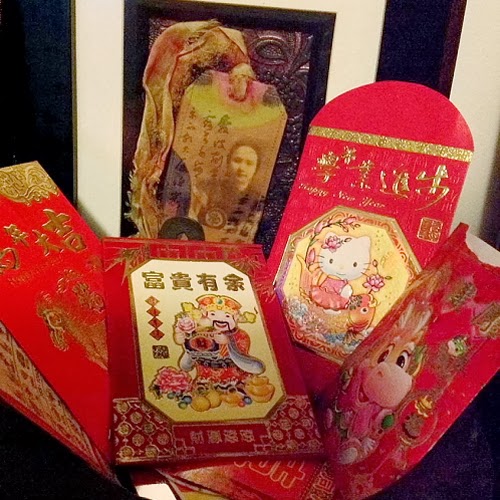In our family, children love red envelopes. They signify special occasions, usually a party, and gifts of money. We have just celebrated the beginning of the Chinese New Year, the Year of the Horse, with the consumption of amazing amounts of delicious food, mah jong challenges for all ages, and with the giving of red envelopes - lai see ( in Cantonese) and hong bao ( in Mandarin) which contained "lucky" money.
Tradition suggests that on auspicious occasions like the lunar new year and weddings, money in the red envelopes means blessings and good luck bestowed on the young by the older generation (the unmarried by the married) and on the bride and groom by the guests. Some employees are also lucky enough to receive red envelopes from their bosses. It is also a happy custom to give red envelopes of money for special services given like Chinese lion dancers in a new year's performance.
Always red, the colour of good luck, the lai see (hong bao) are often gaudily decorated with lots of gold and other bright colours. I have even seen some with colourful images of Disney characters and comical versions of ancient gods and classical figures. It is even fun to make your own with templates now readily online.
In our red envelopes, we put gold coins in an even number as an odd number is usually associated with funerals. However, I believe that crisp new notes are considered better luck, and certainly for weddings, it is not so obvious how much is given if the money is of the folding variety. The grandchildren in our family are very happy with coins, and they love it when I include a couple of coins from another country.They even like a couple of chocolate coins as part of the offering. These red envelopes are always offered with both hands and received by both hands.
Where did this custom of giving red envelopes come from? While there is no literary evidence to prove one theory or another, I like the story that the use of the colour red comes from the time when people used to paste red paper couplets on their front doors to chase away Nien , the ferocious beast which allegedly ate people on New Year's Eve. This developed into the practice of weaving red ribbons or string around coins as "warding off evil spirits money" - often one hundred coins woven in the shape of a dragon. Then with the popularity of the printing press, this practice became red envelopes and paper money.
Whether or not our grandchildren really understand the significance of the lai see (hong bao), they do recognize that this is a Chinese tradition and part of their heritage. It is a very easy custom to maintain, and the red envelopes themselves have become a symbol of unity and continuity of culture.








I think it is a lovely custom and I did enjoy reading how it came about, thank you for sharing.
ReplyDeleteJackie